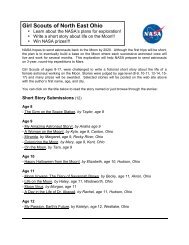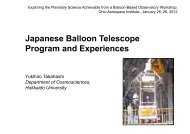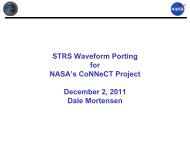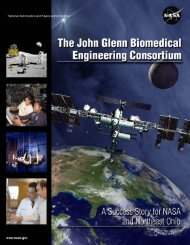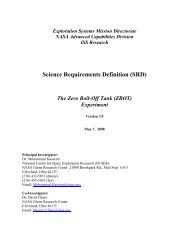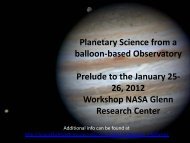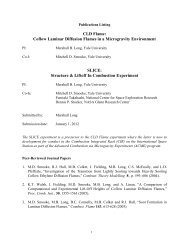Amusement Park Physics With a NASA Twist - Space Flight Systems ...
Amusement Park Physics With a NASA Twist - Space Flight Systems ...
Amusement Park Physics With a NASA Twist - Space Flight Systems ...
You also want an ePaper? Increase the reach of your titles
YUMPU automatically turns print PDFs into web optimized ePapers that Google loves.
Loop-de-loop coasters rarely exceed 3.7 g. This may sound like fun, but for most people these g<br />
loads are more than enough excitement. Accelerating at 9 or 10 g in the wrong direction can<br />
cause the blood (which carries needed oxygen) to drain from a person’s head resulting in tunnel<br />
vision and unconsciousness. If the curves of a roller coaster can make you feel weighted down,<br />
imagine flying a military high-speed aircraft. These jets are built to withstand up to 10 g. Pilots<br />
train to pull 4 to 5 g. Sometimes fighter pilots must handle as many as 10-g loads. How do they<br />
avoid passing out Fighter plane seats are inclined back to prevent blood from draining from the<br />
head. Pilots also wear vests and leg straps with rubber air bladders that automatically inflate to<br />
create pressure on the body to force blood back to the brain. Also, grunting by the pilots tightens<br />
the stomach muscles which helps to bring oxygen back to the brain.<br />
During the space shuttle’s liftoff, until it reaches orbit astronauts experience different g levels. As the<br />
space shuttle takes off, astronauts experience around 1.6 g. During the first 4 seconds of ascent,<br />
the shuttle accelerates from 0 to 100 mph! From that point until the solid rocket boosters burn out<br />
(2 minutes after launch) the accelerations can be as great as 2.5 g. When the solid rocket boosters<br />
are jettisoned, the acceleration drops<br />
dramatically to about 0.9 g. As the<br />
liquid fuel in the engine burns, the<br />
vehicle lightens and the acceleration<br />
slowly increases to 3 g. This acceleration<br />
causes astronauts to experience a<br />
push back into the seat that feels several<br />
times stronger than a commercial<br />
airliner takeoff.<br />
Circular Motion<br />
It is easy to feel high g when circular<br />
motion is involved. The clothes in the<br />
spin cycle of a washing machine can<br />
experience as high as 163 g! In the<br />
loop-de-loop roller coaster the riders<br />
travel in a curved path. They feel<br />
heavy because they are being<br />
pressed against the seat, similar to<br />
the clothes that get pressed against<br />
the walls of the washing machine during<br />
the spin cycle. During the turns, it<br />
is hard for the rider to lift his or her head from the head rest of the car. The same experience that<br />
happens to the rider happens to the clothes in the washing machine, only the acceleration in the<br />
coaster is not as high. While moving in a loop, the acceleration gives you the sensation of high g.<br />
The rider’s inertia causes him or her to keep moving in a straight line (Newton’s first law of<br />
motion), but the roller coaster car and the track forces the rider to change directions.<br />
25<br />
<strong>Amusement</strong> <strong>Park</strong> <strong>Physics</strong> <strong>With</strong> a <strong>NASA</strong> <strong>Twist</strong><br />
EG–2003–03–010–GRC



